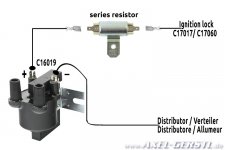Yeah I am pretty sure with that dry twin coil wasted spark setup it does need a ballast resistor. I am sure I have read it somewhere. I will see if I can find out where, probably the fiat club uk forum.
I think you're correct Tony. I read that there are some 126's in which part of the length of the cable that supplies the low tension to the coil is resistive in itself, which cleverly provides the voltage reduction.
The odd thing is that if you simply put a resistor in series with the supply, you lose part of the advantage of having a coil that works at less than 12v. That advantage being that when starting, especially from cold, the voltage drop caused by the starter still allows the low voltage coil to function well. So in a perfect situation, there should actually be a second supply to the coil which bypasses the resistor when actuating the starter.
Interesting info on the link.
http://webshop.fiat500126.com/katalog/artikelinfo/1707/twin-ignition-coil-_cornered
Smurf's coil has 12v stamped on it; as keeps cropping up with all the discussions about charging systems, it seems that the actual voltage running around in the car can be around 14v for most of the time and perhaps that is why the coil needs a resistor?
Where are all the experts when you need them???
Last edited:



